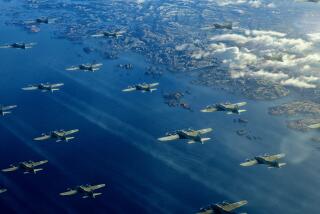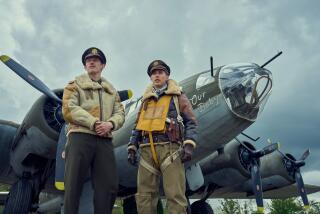Model Planes See Action in Movies : Enterprise: Richard Booth is living out a young boy’s fantasy with his Eaglery, which makes miniature airplanes for movies.
- Share via
Richard Booth has gone through several career changes, from horse trainer to yacht broker to cab driver to assistant director for schlocky, low-budget films. But now he is living out a young boy’s fantasy: He builds and flies model airplanes.
Booth’s Van Nuys-based company, Eaglery, makes radio-controlled, motor-powered model planes for the motion picture industry. Although big action-type films like “Top Gun” use mostly live-action footage of real fighter planes, shots of scale models are often used to supplement the footage of real planes in specific scenes.
Booth admitted that he is still barely scraping by, but after three years of knocking on doors throughout Hollywood, things are finally starting to look up. He just completed work on his first movie, Paramount Pictures Corp.’s “Flight of the Intruder,” a Vietnam-era action-adventure starring Danny Glover, Willem Dafoe and Brad Johnson that is due out this summer.
Booth is now about halfway through work on his second movie, “Black Angel” with Peter Strauss, which is being produced by a small independent production company named Hess Kallberg. Booth has also done model work on four music videos. In July, he will start on another Hess Kallberg production.
There is a reason Eaglery has recently caught filmmakers’ attention: Booth dreamed up a new technique to help make model footage look more realistic.
Booth said that, in the past, whenever he saw movies with shots of model planes mixed in with the live footage, “I would say, ‘I know there’s a better way to do this.’ ”
In those movies, scenes with model planes were always shot from a stationary camera. The models, which are usually about one-fifth to one-eighth the size of a real plane, would zip by the camera and fade out of sight quickly. A realistic-looking shot of a model could only be captured for a split second.
But Booth realized that if the camera were moving as fast as the plane, it would be possible to get film footage that would give the impression that the camera had been attached to another plane flying alongside the plane being filmed. This technique had never been used before, Booth said.
Since coming up with this idea more than three years ago, Booth has made ends meet by driving taxi cabs at night and selling horse racing tickets on weekends. On weekdays, he would work on trying to sell his model plane idea, mailing flyers to “every production company I could find.” Finally, last spring, Hess Kallberg contacted him and arranged to set up a test shoot of one of his models at El Mirage, a dry lake bed east of Palmdale.
With a camera loaded on a truck traveling at 75 m.p.h., Booth, a film crew provided by Hess Kallberg, and several model workers hired by Booth on a piecework basis, created a tape of a one-seventh-scale F-15 model plane that was virtually indistinguishable from footage of a real plane.
“We’ve shown the model footage to many distributors along with live action and defied them to tell the difference,” said Oliver Hess, a principal of Hess Kallberg. “It takes a very savvy eye to tell the difference.”
Armed with the demo tape, Booth contacted Paramount in hope of landing the contract to produce the A-6 Intruder models for “Flight of the Intruder.” Several months later, he got the job. The model filming was completed in March and April at El Mirage and the China Lake Naval Air Station north of Mojave.
Booth said he was paid more than $100,000 for his work on “Flight of the Intruder” but still came out $28,000 in the red because he underestimated the time it would take his 10-man crew to replicate the planes.
The model planes, which have fiberglass bodies and foam core wings and measure up to 10 feet long, were also fitted with mock bombs and missiles that could be dropped or fired from the wings, and some were even manned by miniature “pilots.”
Despite the loss on “Flight of the Intruder,” Booth said he is now solvent because he has been paid by Hess Kallberg for work on two films.
Meanwhile, Booth has also done some work on rock videos, including setting up a mini-camera on a model helicopter to give viewers the impression that they are seeing the world from the air.
Booth also believes his work on “Flight of the Intruder” will open doors for him at other studios. “I was hoping to start with an easy, low-budget movie,” he laughed. But Booth isn’t complaining. “I was really tired of driving taxi cabs,” he said.
More to Read
Only good movies
Get the Indie Focus newsletter, Mark Olsen's weekly guide to the world of cinema.
You may occasionally receive promotional content from the Los Angeles Times.











